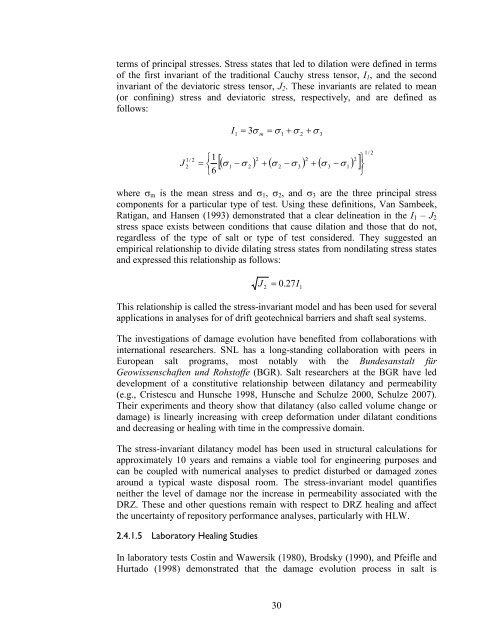Salt Disposal of Heat-Generating Nuclear Waste
Salt Disposal of Heat-Generating Nuclear Waste
Salt Disposal of Heat-Generating Nuclear Waste
Create successful ePaper yourself
Turn your PDF publications into a flip-book with our unique Google optimized e-Paper software.
terms <strong>of</strong> principal stresses. Stress states that led to dilation were defined in terms<br />
<strong>of</strong> the first invariant <strong>of</strong> the traditional Cauchy stress tensor, I 1 , and the second<br />
invariant <strong>of</strong> the deviatoric stress tensor, J 2 . These invariants are related to mean<br />
(or confining) stress and deviatoric stress, respectively, and are defined as<br />
follows:<br />
I<br />
1<br />
= 3σ m<br />
= σ<br />
1<br />
+ σ<br />
2<br />
+ σ<br />
3<br />
J<br />
1/ 2<br />
2<br />
2<br />
2<br />
2<br />
[( σ −σ<br />
) + ( σ −σ<br />
) + ( σ − ) ]<br />
⎧1<br />
= ⎨ 1 2 2 3 3<br />
σ<br />
1<br />
⎩6<br />
⎫<br />
⎬<br />
⎭<br />
1/ 2<br />
where σ m is the mean stress and σ 1 , σ 2 , and σ 3 are the three principal stress<br />
components for a particular type <strong>of</strong> test. Using these definitions, Van Sambeek,<br />
Ratigan, and Hansen (1993) demonstrated that a clear delineation in the I 1 – J 2<br />
stress space exists between conditions that cause dilation and those that do not,<br />
regardless <strong>of</strong> the type <strong>of</strong> salt or type <strong>of</strong> test considered. They suggested an<br />
empirical relationship to divide dilating stress states from nondilating stress states<br />
and expressed this relationship as follows:<br />
J<br />
2<br />
= 0.<br />
27I<br />
This relationship is called the stress-invariant model and has been used for several<br />
applications in analyses for <strong>of</strong> drift geotechnical barriers and shaft seal systems.<br />
The investigations <strong>of</strong> damage evolution have benefited from collaborations with<br />
international researchers. SNL has a long-standing collaboration with peers in<br />
European salt programs, most notably with the Bundesanstalt für<br />
Geowissenschaften und Rohst<strong>of</strong>fe (BGR). <strong>Salt</strong> researchers at the BGR have led<br />
development <strong>of</strong> a constitutive relationship between dilatancy and permeability<br />
(e.g., Cristescu and Hunsche 1998, Hunsche and Schulze 2000, Schulze 2007).<br />
Their experiments and theory show that dilatancy (also called volume change or<br />
damage) is linearly increasing with creep deformation under dilatant conditions<br />
and decreasing or healing with time in the compressive domain.<br />
The stress-invariant dilatancy model has been used in structural calculations for<br />
approximately 10 years and remains a viable tool for engineering purposes and<br />
can be coupled with numerical analyses to predict disturbed or damaged zones<br />
around a typical waste disposal room. The stress-invariant model quantifies<br />
neither the level <strong>of</strong> damage nor the increase in permeability associated with the<br />
DRZ. These and other questions remain with respect to DRZ healing and affect<br />
the uncertainty <strong>of</strong> repository performance analyses, particularly with HLW.<br />
2.4.1.5 Laboratory Healing Studies<br />
In laboratory tests Costin and Wawersik (1980), Brodsky (1990), and Pfeifle and<br />
Hurtado (1998) demonstrated that the damage evolution process in salt is<br />
1<br />
30
















